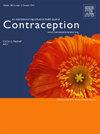医生,家人,还是同龄人?青少年在面对避孕药具的副作用时会找谁
IF 2.3
2区 医学
Q1 OBSTETRICS & GYNECOLOGY
引用次数: 0
摘要
同伴和文化规范在形成青少年态度方面起着关键作用。我们探讨了青少年避孕决策中副作用的影响范围。方法对2023年12月至2024年9月13 ~ 18岁青少年进行半结构化访谈,探讨其避孕经历。我们通过伊利诺斯州提供青少年生殖保健的诊所的传单、雪球抽样和有针对性的社交媒体进行招募。采访调查了副作用的经历,以及青少年在应对副作用时向谁寻求支持。访谈记录和使用Dedoose对主题进行定性分析。结果我们采访了27名青少年参与者(41%的黑人,37%的白人,19%的多种族,11%的西班牙裔或拉丁裔)。青少年认为家庭成员(父母、兄弟姐妹、表兄弟姐妹、阿姨)对其避孕药具的副作用影响最大,特别是当家庭成员有负面经历时。青少年参与者在遇到副作用时向家人寻求建议,管理副作用,并根据他们的副作用经历决定是否应该继续使用这种方法。受访者还根据提供者的建议继续使用或改变避孕方法,并表示较少依赖同伴的建议,因为许多人表示他们的同伴尚未使用避孕措施。许多人都担心在社交媒体上遇到错误信息,尽管有些人报告说,他们从父母或提供者那里获得的副作用信息与社交媒体上分享的用户体验相辅相成。鉴于家庭成员在影响青少年避孕经验方面的重要作用,教育干预应将家庭成员纳入避孕咨询,同时继续以个人隐私和自主权为中心。本文章由计算机程序翻译,如有差异,请以英文原文为准。
DOCTORS, FAMILY, OR PEERS? WHO TEENS SEEK WHEN NAVIGATING CONTRACEPTIVE SIDE EFFECTS
Objectives
Peers and cultural norms play critical roles in shaping adolescent attitudes. We explored spheres of influence in adolescent contraceptive decision making around side effects.
Methods
We conducted semi-structured interviews exploring experiences with contraception from December 2023 to September 2024 among adolescents aged 13 to 18. We recruited via flyers in Illinois clinics providing adolescent reproductive healthcare, snowball sampling, and targeted social media. Interviews examined side effect experiences and who adolescents sought support from when navigating side effects. Interviews were transcribed and qualitatively analyzed for themes using Dedoose.
Results
We interviewed 27 adolescent participants (41% Black, 37% White, 19% multiracial, 11% Hispanic or Latino). Adolescents described family members (parents, siblings, cousins, aunts) as holding the strongest influence over their contraceptive decision making related to side effects, especially when a family member had a negative experience. Adolescent participants sought advice from family members when experiencing a side effect, managing side effects, and deciding whether they should continue a method based on their side effect experiences. Respondents also continued or switched contraceptive methods based on provider recommendations and described relying less on peer advice, since many stated their peers were not yet using contraception. Many shared concerns about encountering misinformation on social media, though some reported supplementing side effect information gained from a parent or provider with user experiences shared on social media.
Conclusions
Given the significant role that family members play in influencing adolescent experiences with navigating contraception, educational interventions should incorporate family members into contraceptive counseling while continuing to center individual privacy and autonomy.
求助全文
通过发布文献求助,成功后即可免费获取论文全文。
去求助
来源期刊

Contraception
医学-妇产科学
CiteScore
4.70
自引率
17.20%
发文量
211
审稿时长
69 days
期刊介绍:
Contraception has an open access mirror journal Contraception: X, sharing the same aims and scope, editorial team, submission system and rigorous peer review.
The journal Contraception wishes to advance reproductive health through the rapid publication of the best and most interesting new scholarship regarding contraception and related fields such as abortion. The journal welcomes manuscripts from investigators working in the laboratory, clinical and social sciences, as well as public health and health professions education.
 求助内容:
求助内容: 应助结果提醒方式:
应助结果提醒方式:


